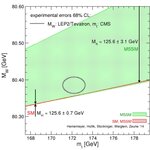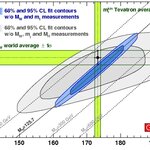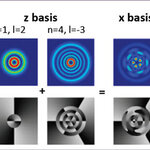Physics

The existence of exotic hadrons — a type of matter that cannot be classified within the traditional quark model - has been confirmed in a forthcoming article prepared by the Large Hadron Collider beauty (LHCb) Collaboration at CERN in Geneva, Switzerland.
Quarks are hard, point-like objects found within the nucleus of an atom. When quarks combine in threes, they form compound particles known as baryons. Protons are probably the best-known baryons. Sometimes, quarks interact with corresponding anti-particles (i.e., anti-quarks), which have the same mass but opposite charges. When this happens…

U.C. Santa Barbara physicist Tarun Grover says he has definitive mathematical evidence for supersymmetry in a condensed matter system. Sought after in the realm of subatomic particles by physicists for several decades, supersymmetry describes a unique relationship between particles.
The fundamental constituents of matter — electrons, quarks and their relatives — are fermions. The particles associated with fundamental forces are called bosons. Several decades ago, physicists hypothesized that every type of particle in the Standard Model of particle physics, a theory that captures the dynamics…

Yesterday I was in Rome, at a workshop organized by the Italian National Institute for Nuclear Physics (INFN), titled "What Next". The event was meant to discuss the plan for basic research in fundamental physics and astrophysics beyond the next decade or so, given the input we have and the input we might collect in the next few years at accelerators and other facilities.
The workshop was a success, with a participation of several hundred colleagues (I believe well over 500). For the first time in many years, INFN discussed openly about its future in the light of the present situation. The…
In February, the University of California, Los Angeles held its 11th Symposium on Sources and Detection of Dark Matter and Dark Energy in the Universe - "Dark Matter 2014" was aimed at discussing the latest progress in the quest to identify dark matter, the umbrella term for the unknown stuff that makes up more than a quarter of the universe yet remains a mystery.
So where does the hunt stand? Between sessions, three leading physicists at the conference spent an hour discussing the search for dark matter on several fronts.
"This conference has highlighted the progression of larger and larger…

If I look back at the first times I discussed the important graph of the top quark versus W boson mass, nine years ago, I am amazed at observing how much progress we have made since then. The top quark mass in 2005 was known with 2-3 GeV precision, the W boson mass with 35 MeV precision, and we did not know where the Higgs boson was, or if there was one.
Today, the top quark mass is measured with a 770 MeV uncertainty and the W boson mass with a 15 MeV uncertainty. That alone is a reduction of a factor of 10 in the allowed phase space of those two parameters; but crucially, we no also know…

The mass of the top quark is a very important parameter of the standard model: using its value together with other no less fundamental ones (the W boson mass, the Higgs mass, and many parameters describing the properties of Z bosons) it is possible to study in great detail the predictions of the theory. In particular, due to the way heavy particles influence the Higgs field, one may verify the consistence of the standard model by looking at a graph where the top quark mass is in the x axis and the W boson on the y axis: different hypotheses for the Higgs boson mass then lie on different…

As I mentioned a few months ago, lately I have been writing a science book for laymen. The idea is to focus on the history of CDF, a particle physics experiment that collected data from 1985 to 2011 at the Fermilab laboratory near Chicago.
Telling the story and the internal sociology of such a glorious and important experiment, which discovered the top quark in 1995 and produced many groundbreaking results in its 30-year-long history, would already be a fine justification of a book; but my aim is a different one - I would like to explain particle physics in a entertaining way, using as a…

In a recent PNAS paper, scientists have described how they managed to achieve a quantum entanglement with a minimum of 103 dimensions with only two particles.
103 dimensions rather than 3? Is that a typo?
Elementary particles such as photons can produce superpositions - where they exist in many possible quantum states simultaneously. In addition, when two particles are entangled a connection is generated so measuring the state of one (whether they are in one place or another, or spinning one way or another, for example) affects the state of the other particle instantly, no matter how far away…

Now that we know that the Higgs boson has a mass of 125 GeV and displays all the properties that a regular standard model Higgs boson should have, one question you could ask is, is it possible that a top quark decays into a Higgs boson ?
The question is a legitimate one since the top quark has a mass 40% larger than the Higgs, so in principle a decay could be allowed. For instance, one could imagine that the top "fluctuates" into a bottom quark - W boson combination, then that the W boson emits a Higgs particle, and finally the bottom quark and W boson fuse themselves into a charm quark. Or…

Would the existence of B-modes in the cosmic microwave background (CMB) radiation be an evidence for inflation? Many influential colleagues claim that this is indeed the case. But their arguments are based on standard cosmological schemes.
Actually, pre-Big Bang patterns beyond conventional cosmology do not require inflation and can generate CMB B-modes.
Two papers by the BICEP2 Collaboration :
BICEP2 I: Detection Of B-mode Polarization at Degree Angular Scales, arXiv:1403.3985BICEP2 II: Experiment and Three-Year Data Set, arXiv:1403.4302
announced the possible finding of a B-mode…